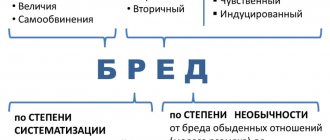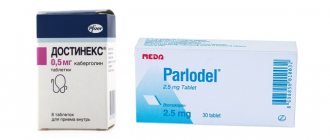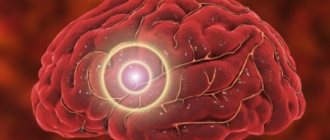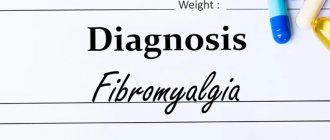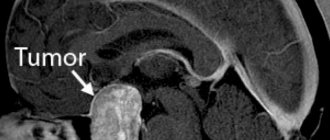Classification of dystonic crises
Vegetative-vascular dystonia occurs due to a violation of vascular tone; its causes may be the following factors:
- periodically experienced stress;
- heredity;
- pathologies in the cervical part of the spinal column;
- skull injuries;
- imbalance of a psychological type.
Important!
Stress and irritability, the inability to relax and gain strength, cause a response from the body, which manifests itself in the development of dystonic crises. Experts identify several types of VSD crises:
- Sympathoadrenal: manifested by pain in the temples, increased blood pressure, discomfort in the chest, rapid heartbeat and anxiety.
- Vagoinsular: expressed in general weakness, nausea, acute lack of air, dizziness. It quickly disappears if a person lies down to rest.
- Hyperventilation: characterized by an acute lack of oxygen, manifested by tachycardia and panic.
- Vegetative-vestibular: manifested by the appearance of pain during a sudden change in body position or posture, as well as active movements.
Panic attacks
During the period of exacerbation of VSD, a person may be seized by a state of panic terror, called a panic attack. A person begins to experience fear that has no basis.
An aggravated course of VSD can cause several types of panic attacks:
- Spontaneous: arising for no apparent reason, without any prerequisites.
- Situational: occurring as a result of the development of certain situations (with a negative ending) that cause an ambiguous reaction in a person.
- Conditional-situational: developing due to a combination of factors, most often caused by hormonal imbalance or alcohol intoxication.
In addition, there are forms in which panic attacks occur:
- Typical, has manifestations in the form of pain in the sternum, increased heart rate, fever and arrhythmia.
- Atypical is characterized by loss of balance, the ability to hear and see, and the onset of fainting.
The periods between the occurrence of an attack and the time without it can vary in time and do not always depend on external factors. This leads to the fact that a person tries to isolate himself from society and spend as little time as possible on the street, among people.
Psychosomatic symptoms of crisis
During clinical observations of patients, the following psychosomatic abnormalities were noted:
- Sense of anxiety;
- Disorientation;
- Depersonalization;
- Increasing fear that has no clear basis.
Often patients are not afraid of any phenomena, people or objects. They panic because of the fear of making a mistake, saying or doing something wrong. If timely measures are not taken to eliminate the symptoms and manifestations of an attack of VSD, then these panic attacks can lead to the development of various phobias and mental disorders.
Exacerbation can be caused by the following factors:
- Lack of sleep;
- Traumatic brain injuries and spinal column injuries;
- Stress;
- Physical and emotional stress;
- Exacerbation of chronic diseases.
A mild exacerbation is usually characterized by two, maximum three symptoms. For example, chills, shortness of breath and tachycardia that occur simultaneously can signal the development of an exacerbation of VSD. Vagoinsular crisis can only manifest itself with a sharp decrease in blood pressure. This suggests that people suffering from vegetative vessels. dystonia, should monitor their health more carefully and at the first, even with a slight exacerbation of vegetative-vascular dystonia, they must immediately take effective measures.
Exacerbations of VSD in different seasons
During the change of seasons, people suffering from vegetative-vascular dystonia are subject to sudden deterioration of their condition, which does not allow them to do their usual activities and requires mandatory consultation with specialists.
Symptoms of VSD in the acute stage have several stages:
- It is characterized by a gradual increase in nervous tension, with the appearance of irrational fear and sharp mood swings.
- It is aggravated by the occurrence of additional symptoms in the form of disorders of the gastrointestinal tract, the occurrence of tachycardia, increased blood pressure and body temperature, and exacerbation of existing headaches.
- It manifests itself as difficulties with focusing vision and the occurrence of dizziness, as well as a combination of other signs of exacerbation of VSD.
We recommend reading: How to treat sweating due to VSD: various treatment options
It is difficult to answer the question of how long an exacerbation of VSD lasts. The duration of the acute period can be only a few days or take the entire season.
First aid in a crisis
It has been noted that vegetative-vascular crises most often occur in the afternoon. This is explained by the fact that throughout the working day the nervous system accumulates tension. By the end of the working day, the stress level reaches its limit.
If a mild exacerbation occurs, it is not necessary to seek help from specialists. Here you can cope on your own if you know all the relief and elimination measures. A mild sedative, soothing tea, meditation or a walk in the fresh air in most cases can cope with the symptoms of a crisis.
In case of a crisis of moderate severity, it will no longer be possible to do without medications. Antidepressants, tranquilizers and sedatives can eliminate symptoms, but they should be used with caution, because they are not safe. The best option is a consultation with a specialist who will compare all the risks and select the most effective treatment for the symptoms of vegetative-vascular dystonia.
Among the safe means for eliminating the symptoms of exacerbation of VSD, the following should be noted:
- Chamomile tea, valerian rhizome, sage, lemon balm;
- Tincture of motherwort and peony.
Before using these drugs, you should study the instructions and make sure there are no contraindications. It is recommended to always keep these pharmaceutical herbs on hand so that when you feel an attack approaching, you can prepare and take them.
If symptoms of exacerbation manifest as severe pain, you should immediately consult a specialist. Here questions may arise: which doctor treats VSD and neuroses, and what measures he will take.
In case of VSD, you should contact a neurologist, because This disease concerns the nervous system. In turn, the doctor will identify all the nuances of the exacerbation and prescribe a course of treatment. This could be vitamin injections, manual therapy, a course of sedatives, etc. There is no need to eliminate symptoms separately, for example, treating a lump in the throat due to VSD, because Symptoms subside as the neurosis subsides.
Spring exacerbations
Quite often, the course of VSD worsens in the spring, when a climate change occurs, triggering some previously dormant processes in the human body.
The period of spring exacerbation can begin in both March and May. Everything here is strictly individual and difficult to predict.
If vegetative-vascular dystonia worsens in the spring, it is accompanied by the occurrence of the following symptoms:
- panic state;
- emergence or worsening of phobias;
- worsening mood;
- headache;
- increased heart rate;
- temperature increase;
- sudden changes in blood pressure;
- Difficulty performing daily work functions.
A relapse can last for different periods of time, and it depends on the state of the body at a particular point in time.
click to enlarge
Mode for VSD
Violation of the work and leisure regime significantly affects all human organs and systems, primarily the nervous and cardiovascular systems. With vegetative-vascular dystonia, all symptoms can worsen many times, which is why it is so important to properly build a daily routine:
- It is necessary to accustom yourself to go to bed and get up at the same time, to sleep at least 7-8 hours a day. It is advisable to accustom yourself to be in a state of sleep from 23:00 to 3:00: during this time, hormones are produced that regulate the activity of the heart and blood vessels, and important protein compounds are synthesized.
- You should organize your work activities competently: avoid excessive workload, alternate work and rest. The workplace should be well ventilated and lit: this helps improve productivity and reduces stress. A stuffy workplace can be one of the causes of headaches. If it is not possible to ventilate the room, you need to go out into the air during breaks.
- For any type of dystonia, it is recommended to spend at least an hour in the fresh air in the warm season, and about forty minutes in the winter.
- During the period of spring exacerbation, it is better to give up smoking and drinking alcohol: ethanol and nicotine worsen the condition of blood vessels, leading to spasms and lack of blood supply. In addition, ethanol negatively affects the central nervous system. The combination of dystonia with regular consumption of alcoholic beverages gives rise to psychosis, increases depression and leads to suicidal mood.
- Choosing a method of rest: the preferred rest depends on the type of load the patient receives during working hours. For those who work physically, quiet rest and moderate mental activity are recommended: for example, reading books, solving puzzles, board games. For those who receive intellectual stress at work, it is necessary to diversify the regimen with physical activity: race walking, swimming, cycling.
- Diet plays an important role: with dystonia, due to appetite disturbances, weight can either decrease or increase uncontrollably. It is necessary to eat at strictly defined hours, exclude high-carbohydrate foods, fast food and canned foods. It is better to avoid strong tea and coffee, as caffeine constricts blood vessels, raises blood pressure and increases the heart rate.
The fight against stress plays a special place in the treatment of VSD.
Prevention of VSD
To protect against vegetative-vascular dystonia, you must fulfill several simple requirements:
- Spend enough time outdoors, walk more.
- It is better to refrain from watching TV shows immediately before bed.
- To combat stress, you need to start a hobby that would distract you from heavy thoughts and help you calm down: creative activities, such as beadwork and needlework, help a lot. For men, sports and a passion for technology can be a good relaxation.
- It is necessary to solve all problems in a timely manner: financial, domestic and personal, to establish relationships with loved ones and work colleagues.
- To gain self-confidence and resolve some psychological difficulties, it is advisable to seek help from a psychologist or psychotherapist: he will help you understand yourself and get rid of fears.
- Regular sex life also relieves the symptoms of vegetative-vascular dystonia.
- You need to pay enough attention to a healthy diet: all the necessary vitamins and microelements should be included in the diet; in winter, you need to take multivitamin complexes and biological supplements to strengthen the immune system.
The most important thing during an exacerbation of dystonia is not to give in to panic and control yourself. Proper prevention will strengthen the body and help avoid exacerbations of dystonia.
DO YOU STILL THINK THAT IT IS IMPOSSIBLE TO GET RID OF VSD FOREVER!?
Autumn exacerbations
In the treatment and prevention of VSD, taking care of your own health during the onset of autumn, when the body is exposed to many viruses and infections, is of great importance.
During this period, people with VSD exhibit the following symptoms:
- disruption of the proper functioning of internal organs;
- development of prolonged depression;
- elevated temperature during sunrise;
- loss of appetite;
- disruptions in the gastrointestinal tract;
- unreasonable fears during VSD, insomnia developing during this period;
- loss of sensation in the upper and lower extremities.
Winter exacerbations
Vegetative changes can also worsen in winter, when the body does not experience serious shocks. According to experts, it is during this period, if the correct lifestyle is not followed, that exacerbations occur most often.
In winter, people who have worsened vascular dystonia have the question of what to do with the following symptoms:
- more frequent attacks of despondency;
- panic attacks that occur at different times of the day;
- changes in body temperature;
- increased heart rate;
- the occurrence of leg cramps;
- the appearance of breathing difficulties.
Summer exacerbations
In the eyes of a layman, an exacerbation of VSD in the summer is unlikely, but in reality, this is not the case. High air temperatures, changes in humidity and increased solar activity negatively affect the body, causing exacerbations.
Manifestations of dystonia in summer are expressed in the occurrence of:
- breathing difficulties;
- pain in the forehead;
- dizziness;
- fainting;
- loss of appetite;
- weight loss;
- disappearance of the desire to move.
We recommend reading: Burning sensation in the chest with VSD
Prevention of exacerbations
In order to avoid or minimize the number of VSD crises, it is necessary not only to regularly visit specialists and take medications. Here you need to completely change the rhythm of your life. First of all, you should reduce the load on the nervous system or consider a course of daily fasting, which allows you to relieve tension. For example, yoga and meditation are very popular among dystonics.
Regarding nutrition, some adjustments should also be made. Now your daily diet should contain vitamins, microelements, and polyunsaturated fatty acids. It is recommended to add soothing herbs to tea and spend time outdoors more often.
Dystonics are recommended to do yoga
It would be ideal if a patient with VSD can find a job or activity that will not negatively affect the nervous system, and eliminate all harmful factors from his life so that they cannot provoke an exacerbation of VSD.
Exacerbation in pregnant women
Pregnancy is a special condition in which the slightest negative symptoms can cause disturbances in the functioning of the entire body. Therefore, it is so important for a woman diagnosed with VSD to monitor her own condition and promptly monitor the occurrence of such dangerous symptoms as:
- depression that lasts for several days and even weeks;
- sleep problems;
- nausea;
- constant fatigue;
- headache.
Click to enlarge
Causes of VSD
Vegetative-vascular dystonia is a violation of vascular tone and autonomic dysfunction. The causes of vegetative-vascular dystonia can be the following factors:
- Periodic stress;
- Heredity;
- Disturbances in the functioning of the cervical spine;
- Traumatic brain injuries;
- Psychological imbalance.
Frequent stress, irritability, and fussiness deplete the nervous system, which leads to the body developing a specific reaction to the effects of stress. This reaction is seizures.
Exacerbation after alcohol intoxication
Alcohol intoxication in itself can seriously undermine a person’s health.
Acute manifestations of VSD in such people are manifested by the following symptoms:
- the appearance of negative emotions and bad thoughts;
- debilitating headaches;
- nausea;
- sudden changes in blood pressure;
- attacks of loss of control over breathing.
click to enlarge
Treatment methods
The universal way to stop an attack is a full night's sleep. However, in severe crises, it is necessary to urgently consult a doctor.
Treatment of crisis is symptomatic. If you have a headache, take an analgesic; if you have high blood pressure, take an antihypertensive drug. You should definitely take a sedative. Otherwise, treatment is aimed not at eliminating the crisis, but at preventing re-exacerbation.
Medications
Treatment of VSD consists of taking the following groups of medications:
- sedatives;
- tranquilizers - for panic attacks and anxiety;
- antidepressants – for severe asthenia and depression;
- means for normalizing blood pressure - according to indications;
- drugs to improve cerebral circulation, nootropics;
- vitamins and biostimulants.
The treatment regimen is individualized for each person and depends on which symptoms predominate outside of exacerbation.
Psychotherapy
It will not be possible to stop an attack with the help of psychotherapy; this method of treatment is aimed at learning to control one’s own emotions. Working with a psychotherapist will help you get rid of phobias and groundless anxiety, and will also teach you how to cope with stress on your own.
Physiotherapy and herbal medicine
Drops are taken after meals
For effective treatment of VSD, it is recommended to undergo a course of physical therapy. This could be electrophoresis, electrosleep, manual therapy or magnetic therapy. The choice of method is made by the doctor.
Among folk remedies, you can take herbal teas and sedative decoctions and infusions - valerian, motherwort, chamomile or lemon balm.
Exacerbations due to stress
When a person is under stress, he feels intense overexcitement caused by increased production of adrenaline. The heart and blood vessels are depleted by such changes, which leads to disruption of their functioning.
Stress exacerbations of VSD are the most severe for the body; they manifest themselves with the following symptoms:
- despondency;
- changes in blood pressure;
- pain in the heart area;
- dyspnea;
- dizziness;
- discomfort in the stomach;
- frequent urination.
Stress is especially common due to lack of sleep while traveling. Moreover, even the use of maintenance medications does not always give the expected effect.
How does autumn affect dystonia?
Of course, a person can encounter all the “delights” of VSD at any time of the year - certain weather conditions are not required for the symptoms of this disease to appear. The main signs of dystonia are:
- panic attacks accompanied by fear of death;
- headaches, dizziness;
- tachycardia, blood pressure surges;
- increased causeless anxiety;
- nervousness, irritability;
- respiratory problems (difficulty taking a full breath);
- frequent urination;
- sleep problems;
- various gastrointestinal disorders.
All of these symptoms cause dystonics a lot of problems under normal circumstances. With the change of seasons (especially from summer to autumn), the symptoms become more pronounced. The fact is that during this period the body undergoes a restructuring - it adjusts to the onset of cold weather. The weather becomes unstable, a person’s immunity decreases, the risk of catching a cold increases, and strength and energy become less. In addition, there is a theory that dystonics can be driven into stress by the autumn landscape itself - a dull gray sky, rain, puddles on the roads. Observing such a picture, a person with an overly susceptible nervous system begins to worry and involuntarily think about the bad, to expect unpleasant developments of events. Gloomy thoughts, in turn, lead to an exacerbation of unwanted manifestations. Exacerbation of VSD in the fall can be expressed by many signs.
- Increased fears, frequent thoughts of death. During this period, a person is overly concerned about his health, he is afraid that he will be diagnosed with one or another dangerous disease, the slightest unpleasant manifestations can cause great anxiety.
- Sleep disorders. In autumn, dystonics, as a rule, often suffer from insomnia, have strange dreams, and often wake up at night. In the morning they do not feel cheerful and energetic, and feel drowsy during the day.
- Anxiety, bad thoughts. At the end of summer, dystonics often begin to be haunted by attacks of inexplicable anxiety, concern for the future and future prospects. At the same time, it seems to them that all events in their lives will certainly develop according to the worst-case scenario.
- Discomfort in different parts of the body, breathing disorders. Patients with VSD in the fall may experience various unpleasant sensations in the chest, abdomen or head. However, such discomfort is usually not associated with any organic disease. Also, with the onset of unstable weather, dystonics find it difficult to breathe; the feeling of insufficient inhalation can bother them throughout the day.
- General deterioration in condition, irritability, weakness throughout the day. Changing weather conditions can lead to dizziness, changes in blood pressure, outbursts of irritability and even aggression.
We recommend reading: Feeling anxious in the morning - what does it mean?
In addition, when the weather changes, dystonics often lose their appetite, their facial skin becomes pale, and they experience pain and tension in the chest area.
